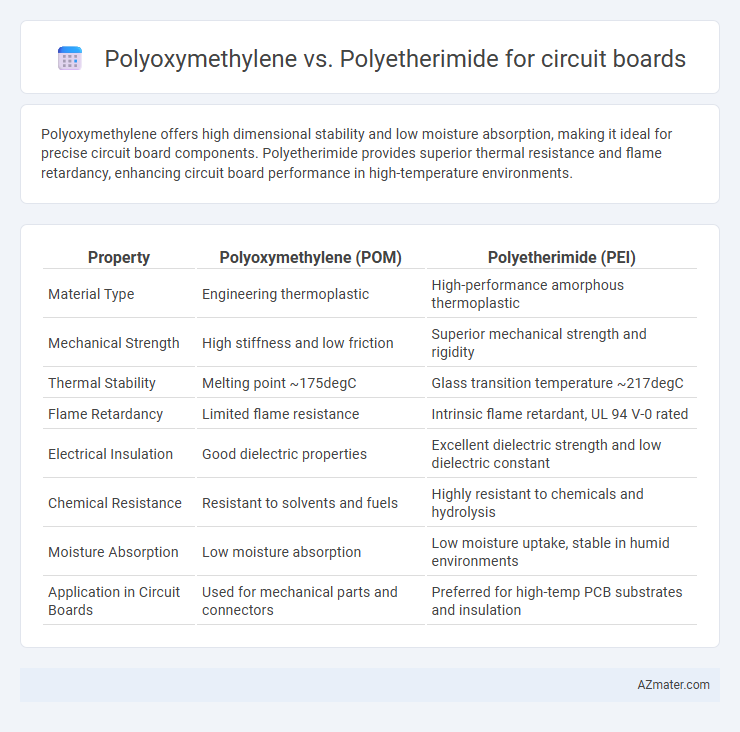Polyoxymethylene offers high dimensional stability and low moisture absorption, making it ideal for precise circuit board components. Polyetherimide provides superior thermal resistance and flame retardancy, enhancing circuit board performance in high-temperature environments.
Table of Comparison
| Property | Polyoxymethylene (POM) | Polyetherimide (PEI) |
|---|---|---|
| Material Type | Engineering thermoplastic | High-performance amorphous thermoplastic |
| Mechanical Strength | High stiffness and low friction | Superior mechanical strength and rigidity |
| Thermal Stability | Melting point ~175degC | Glass transition temperature ~217degC |
| Flame Retardancy | Limited flame resistance | Intrinsic flame retardant, UL 94 V-0 rated |
| Electrical Insulation | Good dielectric properties | Excellent dielectric strength and low dielectric constant |
| Chemical Resistance | Resistant to solvents and fuels | Highly resistant to chemicals and hydrolysis |
| Moisture Absorption | Low moisture absorption | Low moisture uptake, stable in humid environments |
| Application in Circuit Boards | Used for mechanical parts and connectors | Preferred for high-temp PCB substrates and insulation |
Introduction to Polyoxymethylene (POM) and Polyetherimide (PEI)
Polyoxymethylene (POM) is a high-performance thermoplastic known for its excellent mechanical strength, low friction, and dimensional stability, making it suitable for precision components in circuit boards. Polyetherimide (PEI) features superior thermal resistance, electrical insulation properties, and flame retardancy, ideal for advanced electronic applications requiring reliable performance under high heat. Both POM and PEI are engineered polymers frequently used in electronics, with POM excelling in mechanical resilience and PEI in thermal and electrical performance.
Key Material Properties: POM vs PEI
Polyoxymethylene (POM) offers excellent dimensional stability, low moisture absorption, and high stiffness, making it ideal for precise circuit board components requiring mechanical strength and wear resistance. Polyetherimide (PEI) excels with superior thermal stability, high glass transition temperature (around 217degC), and outstanding flame retardancy, enabling use in high-temperature circuit board applications and environments demanding strict UL94 V-0 standards. POM suits electrically insulating parts with moderate thermal demands, whereas PEI supports advanced circuit boards needing robust thermal endurance and chemical resistance.
Thermal Stability and Heat Resistance Comparison
Polyoxymethylene (POM) displays moderate thermal stability with a melting point around 175degC, limiting its use in high-temperature circuit board applications. Polyetherimide (PEI) exhibits superior heat resistance, maintaining mechanical integrity up to 215degC and continuous service temperatures near 170degC, making it ideal for demanding electronic environments. The high glass transition temperature of PEI contributes to enhanced dimensional stability and performance under thermal stress compared to polyoxymethylene.
Electrical Insulation Capabilities
Polyoxymethylene (POM) offers moderate electrical insulation with a dielectric strength typically around 20-30 kV/mm, making it suitable for general-purpose circuit board components requiring mechanical stability. Polyetherimide (PEI) provides superior electrical insulation, boasting a high dielectric strength exceeding 40 kV/mm and excellent thermal resistance, which enhances performance in high-temperature electronic applications. The enhanced dielectric properties and thermal endurance of PEI make it a preferred material for advanced circuit boards demanding reliable electrical insulation under harsh operating conditions.
Mechanical Strength and Durability
Polyoxymethylene (POM) offers high mechanical strength and excellent wear resistance, making it suitable for circuit boards requiring precision and durability under repetitive stress. Polyetherimide (PEI) provides superior thermal stability and mechanical strength, maintaining performance in high-temperature environments while offering enhanced chemical resistance. PEI's durability under thermal cycling and mechanical load makes it a preferred choice for advanced circuit board applications with demanding operational conditions.
Chemical Resistance and Environmental Suitability
Polyoxymethylene (POM) offers excellent chemical resistance against solvents, oils, and fuels, making it suitable for circuit board applications exposed to harsh chemicals. Polyetherimide (PEI) excels in high-temperature environments with superior resistance to hydrolysis and radiation, ensuring durability in demanding electronic settings. PEI's ability to maintain mechanical integrity under extreme thermal and chemical stress provides a more versatile choice for environmentally challenging conditions on printed circuit boards.
Application Performance in Circuit Board Manufacturing
Polyoxymethylene (POM) offers high dimensional stability and excellent electrical insulation, making it suitable for precision components in circuit board assemblies, especially where mechanical strength and low friction are critical. Polyetherimide (PEI) exhibits superior thermal resistance and flame retardancy, enabling its use in high-performance circuit boards subject to elevated temperatures and stringent safety standards. The choice between POM and PEI depends on specific application requirements such as thermal endurance, mechanical stress, and electrical reliability in circuit board manufacturing.
Cost Efficiency and Material Availability
Polyoxymethylene (POM) offers superior cost efficiency for circuit boards due to its lower raw material price and ease of processing, making it suitable for high-volume, budget-sensitive applications. Polyetherimide (PEI) provides higher thermal stability and mechanical strength but at a significantly higher cost and with more limited availability from suppliers. Manufacturers prioritize POM when cost constraints dominate, whereas PEI is selected for high-performance circuit boards requiring enhanced durability and heat resistance.
Processing and Fabrication Considerations
Polyoxymethylene (POM) offers excellent dimensional stability and ease of machining, making it suitable for high-precision circuit board components, while its low moisture absorption enhances fabrication reliability. Polyetherimide (PEI) exhibits superior thermal resistance and chemical stability, requiring higher processing temperatures and careful thermal management during fabrication to prevent warping or degradation. Selecting between POM and PEI depends on balancing POM's ease of processing with PEI's enhanced performance in demanding thermal and chemical environments.
Summary: Choosing the Right Material for Circuit Boards
Polyoxymethylene (POM) offers excellent dimensional stability and low moisture absorption, making it suitable for precise, high-volume circuit board applications requiring mechanical strength and wear resistance. Polyetherimide (PEI) provides superior thermal stability, high dielectric strength, and flame retardance, critical for circuit boards operating under high temperatures and demanding electrical performance. Selecting the right material depends on balancing mechanical requirements with thermal and electrical needs, ensuring reliability and longevity in circuit board design.

Infographic: Polyoxymethylene vs Polyetherimide for Circuit board
 azmater.com
azmater.com